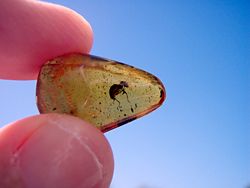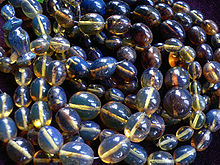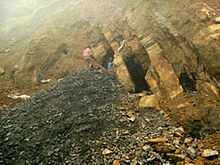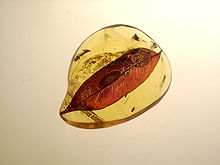- Dominican amber
-
 Worker Termite in Dominican Amber
Worker Termite in Dominican Amber
Dominican amber is amber from the Dominican Republic. Resin from the extinct species Hymenaea protera is the source of Dominican amber and probably of most amber found in the tropics.
Dominican amber differentiates itself from Baltic amber by being nearly always transparent, and it has a higher number of fossil inclusions. This has enabled the detailed reconstruction of the ecosystem of a long-vanished tropical forest.[1]
Contents
Age
A study in the early 1990s returned a date up to 40 million years old.[2] However according to Poinar,[1] Dominican amber dates from Oligocene to Miocene, thus about 25 million years old. The oldest, and hardest of this amber comes from the mountain region north of Santiago. The La Cumbre, La Toca, Palo Quemado, La Bucara, and Los Cacaos mining sites in the Cordillera Septentrional not far from Santiago.[3] Amber has also been found in the south-eastern Bayaguana/Sabana de la Mar area. There is also subfossil copal found with an age of only 17-15 million years.[citation needed]
Mining sites
 A rare set of Arab worry beads (masbaha) made of blue amber.
A rare set of Arab worry beads (masbaha) made of blue amber.
There are three main sites in the Dominican Republic where amber is found: La Cordillera Septentrional, in the north, and Bayaguana and Sabana de la Mar, in the east. In the northern area, the amber-bearing unit is formed of clastic rocks, washed down with sandstone fragments and other sediments that accumulated in a deltaic environment, even in water of some depth.[4][5][6]
In the eastern area, the amber is found in a sediment formation of organic-rich laminated sand, sandy clay, intercalated lignite, and as well as some solvated beds of gravel and calcarenite.[7]
Both areas seem to have been part of the same sedimentary basin but were later disrupted by movements along major faults.[8]
Mining
Dominican Amber, and especially Dominican blue amber is mined through bell pitting, which is extremely dangerous. The bell pit is basically a foxhole dug with whatever tools are available. Machetes do the start, some shovels, picks and hammers may participate eventually. The pit itself goes as deep as possible or safe, sometimes vertical, sometimes horizontal, but never level. It snakes into hill sides, drops away, joins up with others, goes straight up and pops out elsewhere. 'Foxhole' applies indeed: rarely are the pits large enough to stand in, and then only at the entrance. Miners crawl around on their knees using short-handled picks, shovels and machetes.
There are little to no safety measures. A pillar or so may hold back the ceiling from time to time but only if the area has previously collapsed. Candles are the only source of light. Humidity inside the mines is at 100%. Since the holes are situated high on mountainsides and deep inside said mountains, the temperature is cool and bearable, but after several hours the air becomes stale. During rain the mines are forced to close. The holes fill up quickly with water, and there is little point in pumping it out again (although sometimes this is done) because the unsecured walls may crumble.[9]
Variations
Dominican amber can be found in many colors, besides the obvious amber. Yellow and honey colored are fairly common. There is also red and green in smaller quantities and the rare blue amber (fluorescent).[10][11]
The Museo del Ambar Dominicano, in Puerto Plata, as well as the Amber World Museum in Santo Domingo have collections of amber specimens.
Paleobiology
Numerous organisms have been described from amber specimens including:
Flora
- Hymenaea protera
- Palaeoraphe
- Roystonea palaea
Fauna
- Araneagryllus
- Augochlora leptoloba
- Eickwortapis
- Electromyrmococcus[12]
- Leptofoenus pittfieldae
- Lutzomyia adiketis[13]
- Neocorynura electra
- Nesagapostemon
- Oligochlora
- Paleoleishmania neotropicum[13]
- Tainosia[14]
- Termitaradus mitnicki
- Triatoma dominicana
- Trypanosoma antiquus
- Sphaerodactylus dommeli
See also
References
- ^ a b George Poinar, Jr. and Roberta Poinar, 1999. The Amber Forest: A Reconstruction of a Vanished World, (Princeton University Press) ISBN 0691028885
- ^ Browne, Malcolm W. (1992-09-25). "40-Million-Year-Old Extinct Bee Yields Oldest Genetic Material". New York Times. http://query.nytimes.com/gst/fullpage.html?sec=health&res=9E0CE2DD123BF936A1575AC0A964958260. Retrieved 2008-04-15.
- ^ Corday, Alec (2006). "Dominican Amber Mines: The Definitive List". The Blue Amber Blog. Archived from the original on 2008-04-20. http://web.archive.org/web/20080420083549/http://ambarazul.com/wordpress/2006/09/. Retrieved 2008-04-15.
- ^ Leif Brost and Ake Dahlstrom. The Amber Book, Geoscience Press, Inc., Tucson , AZ, 1996 ISBN 0-945005-23-7
- ^ Wilfred Wichard und Wolfgang Weitschat: Im Bernsteinwald. - Gerstenberg Verlag, Hildesheim, 2004, ISBN 3-8067-2551-9
- ^ Baroni Urbani, C. & Saunders, J.B. (1980): The fauna of the Dominican Republic amber: the present status of knowledge. – Memorias, 9a geologica del Caribe, 1: 213-223; Santo Domingo. (Published 1983).
- ^ Schlee, D. (1984): Besonderheiten des Dominikanischen Bernsteins. – Stuttgarter Beitr. Naturk., C, 18: 63-71; Stuttgart.
- ^ Manuel A. Iturralde-Vennet 2001. Geology of the Amber-Bearing Deposits of the Greater Antilles. Caribbean Journal of Science, Vol. 00, No. 0, 141-167, 2001
- ^ Martínez, R. & Schlee, D. (1984): Die Dominikanischen Bernsteinminen der Nordkordillera, speziell auch aus der Sicht der Werkstaetten. – Stuttgarter Beitr. Naturk., C, 18: 79-84; Stuttgart.
- ^ Schlee, D. (1980): Bernstein-Raritaeten (Farben, Strukturen, Fossilen, Handwerk). – 88 S. (mit 55 Farbtafeln); Staatl. Museum fuer Naturkunde) Stuttgart.
- ^ L. Linati and D. Sacchi, V. Bellani, E. Giulotto (2005). "The origin of the blue fluorescence in Dominican amber". J. Appl. Phys. 97, 016101. doi:10.1063/1.1829395 doi:10.10.1063/1.1829395.
- ^ Johnson, M.S.; et al (2001). "Acropyga and Azteca Ants (Hymenoptera: Formicidae) with Scale Insects (Sternorrhyncha: Coccoidea): 20 Million Years of Intimate Symbiosis". American Museum Novitates 3335: 1–18. doi:10.1206/0003-0082(2001)335<0001:AAAAHF>2.0.CO;2.
- ^ a b Poinar, G. (2008). "Lutzomyia adiketis sp. n. (Diptera: Phlebotomidae), a vector of Paleoleishmania neotropicum sp. n. (Kinetoplastida: Trypanosomatidae) in Dominican amber". Parasites & Vectors 1 (1): 22. doi:10.1186/1756-3305-1-22. PMC 2491605. PMID 18627624. http://www.pubmedcentral.nih.gov/articlerender.fcgi?tool=pmcentrez&artid=2491605.
- ^ Szwedo, J.; Stroiński, A. (2001). "Tainosia quisqueyae gen. and sp. nov. from the Oligocene/Miocene Dominican amber (Hemiptera: Fulgoroidea: Nogodinidae)". Genus 12 (1): 29–34. http://ag.udel.edu/delpha/5325.pdf.
External links
- PBS NOVA "Amber: Jewel of the Earth"
- ISEM Research: Anolis lizard in amber
- American Museum of Natural History: Amber: Window to the Past, 1998
- Life in Amber includes numerous further links
- Christine Lipkin, "Geological setting and age of the Dominican Republic"
- Dominican Amber Mines: The Definitive List
Wikimedia Foundation. 2010.


